What is the difference between hiragana and katakana. Why do we need two ABCs.
Learning Japanese includes three sections. In the first, we learn hieroglyphs that mean whole words. They are borrowed mainly from Chinese literacy, but slightly modified. This section is called Kanji. Then the Japanese alphabet is studied - hiragana and katakana. These two writing systems consist of syllables that give the Japanese language distinctiveness and uniqueness. Well, let us examine in order what the whole Japanese alphabet is, how to learn it and what it is based on.
These books open like western prints. There are many Chinese words in Japanese. Today, these borrowings are part of everyday language and are not considered foreigners. Due to the strong cultural influence of China, most of the words related to philosophy, science and art are of Chinese origin. New ideas that came from the West in the late nineteenth and early twentieth centuries are often translated as combinations of Chinese characters, and these words represent a significant part of the vocabulary of the modern Japanese.
Cana
This is a generic name for the Japanese writing and reading system, which covers both hiragana and katakana. A cana consists of graphic records - that is, hieroglyphs that have a certain sequence of writing lines and a certain appearance. For example, hiragana syllables have rounded shapes and steep endings. In Katakana, the hieroglyphs are more angular and accurate in spelling. Modern Japanese people rarely use Kana as an independent system of writing or sayings. As a rule, this native Japanese alphabet plays a supporting role when explanations are needed for some kanji characters, or other languages.
To these foreigners are added many words in English and other European languages. As a rule, new Westerners introduce the Japanese language unchanged in form, for example, the volunteer "announcer" and others. The Japanese compose pseudo-English words like night games, night lights and paychecks. Recently, this trend has grown. Although much smaller, there are a number of Japanese words that have come in and are based on Western and other languages. Examples include anime, geisha, haiku, kamikaze, karaoke, kimono, manga, ninja, samurai, origami, saku, sushi, karate, judo, sumo, sudoku, ikebana, hakaki, tsunami.
Kana Record
Unlike kanji, where hieroglyphs can be written in any way, the sequence of line drawing plays a very important role in native Japanese. How the hieroglyph will be written can help determine its author, establish, so to speak, the owner’s handwriting, and sometimes even affect its meaning. In addition, the alphabet of the Japanese language has such strict rules for writing hieroglyphs not only for the sake of unification. Adhering to them, you will be able to draw the sign you need as soon as possible, and neglect of the rules will delay the writing process. 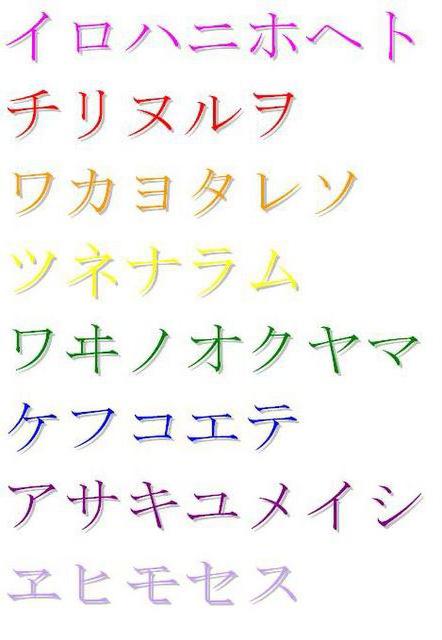
The Japanese have developed a whole system of respectful linguistic styles called kayo, which expresses the respect of the speaker to the person whom he speaks. This includes various language styles and a wide range of words and phrases. Improved use of the test allows you to achieve the required degree of politeness. A simple sentence can sometimes be formulated in 20 different ways, depending on the social status of the speaker.
Choosing the right level of politeness is too complicated, because it is determined by a complex combination of factors such as social status, position, age, gender, even the services provided or services to the addressee. There is a neutral middle level of language that is used when two people meet for the first time and have a similar social status. In general, women are more polite than men, and in most cases use polite language.
Hiragana and its description
This type of writing is used to write down words that are not in kanji. This is necessary in cases where the writer does not know certain hieroglyphs or does not fully understand their meaning. In this writing system, one sign denotes one mora (i.e., a Japanese syllable). Therefore, to write a word, you need to use two or more characters. This Japanese alphabet can transmit three types of sounds. The first is any vowel; the second is the combination of consonant and vowel that follows it; the third is the nasal sonant. It is noteworthy that the last category of sounds in Japanese can sound very harsh (Russian “n”, “m”), and have a certain “French” accent. 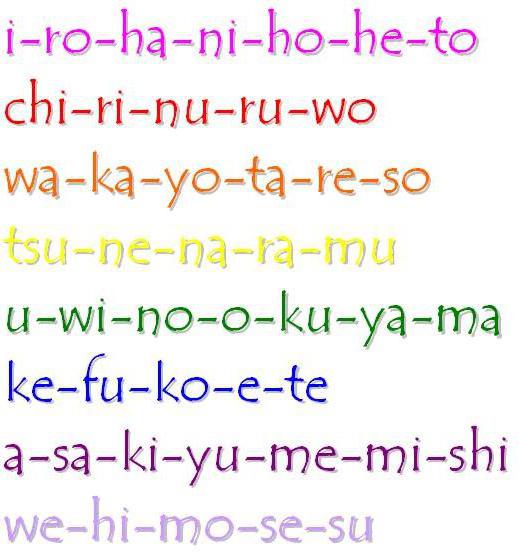
Achieving perfection in the cage is not easy, and some Japanese are much better than others. There are many ways to achieve the required level of politeness using different parts of speech - nouns, adjectives, verbs and adverbs. Complaints are used when we contact the addressee or talk about his relatives, his house or things. On the contrary, the speaker uses words and expressions that express humility when he speaks for himself. These two opposites define the expression of the necessary respect for the addressee.
The Japanese have their own names and surnames, which are written and pronounced in this sequence. However, in newspapers and magazines published in Japan in English, the first names, and then the last names, as a rule, are written first, as is customary in the West. When we turn to someone, we usually use the dignity, which is equivalent to “gentleman”, “lady” or “lady” after the last name. Other names, such as “sensei” for “teacher” or “doctor,” are also added as suffixes after the last name.
Origin of writing
The Japanese alphabet of hiragana was born around the 5th century. Her ancestor is considered a manegan. This complex word refers to the writing system that was in use in Japan until the advent of hiragana. With its help, hieroglyphs were written, which sounded about the same as Chinese, but were written in a completely different way. In fairness, it is worth noting that later, when the manegan was transformed, the influence of the Chinese language on it became even greater. Hiragana was born by writing these ancient characters in the Tsaoshu style, which was inherent. Such a metamorphosis made many written characters change their forms beyond recognition. And, perhaps, only a professional for whom Japanese is his native language can find similarities between the modern writing system. 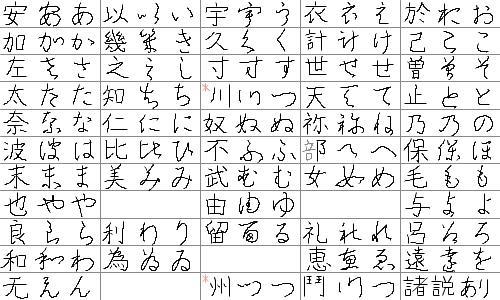
The names and corresponding Chinese characters with which they are written are chosen according to their meaning, in the hope that this will bring the child a lot of luck. At that time, typing in Japanese, you need bulky cars. Using mobile phones to send text messages via e-mail or simply because the message is very popular in Japan, especially after young people. Text input is mainly done with the thumb, which is used to press the telephone keypad several times, and the desired character or jug \u200b\u200bis selected.
How to quickly learn hiragana
This Japanese alphabet, oddly enough, contains quite a few characters that are easy to remember. For this, there is a unique poem - Iroha, which translates as “flower song”. it was written in the 10th century, and since then the sound of many written signs has changed, as a result of which the rhyme has also disappeared. However, you can learn it, which will help to quickly remember the whole alphabet of hiragana. In pictures, the poem is given in the original, in Japanese, and next to it there is a transcription in Latin.
When writing emails from a computer, there is a tendency to frequently use abbreviations, signs and symbols, which are actively used in queue messages. When children who actively communicate with mobile phones and computers as active children grow up and work, they inevitably come up with their written habits and change the use of written Japanese.
If we want to write, for example, the word "hello", gradually write the four letters of which the word consists. We already know all this from the first class. But all of us, no doubt, are familiar with the fact that not everyone in the world uses our Latin. Russians have Cyrillic scripts in the Latin alphabet; the principle itself is recalled; in Korea again, Hangul are used, which is similar to the Latin alphabet already much less, but we, of course, will be more than the Latin, Cyrillic or HANGUL script interested in Japanese. The Japanese used to write three fonts and kanji, which are actually taken from Chinese characters, and two syllabic alphabets, hiragana and katakana, which is dedicated to this article.
Description of Katakana
The system of this writing cannot exist autonomously, at least in modern Japanese. The Japanese alphabet of katakana is used to describe phenomena, objects or names that are of foreign origin, including Russian or European origin. Also, hieroglyphs of this group are often found in paintings, poems and prose. This is necessary in order to give the work a special, unique color. Also, very often katakana catches our eye in the correspondence of people, in their colloquial speech (mainly in the regions of Japan), in foreign posters and slogans. 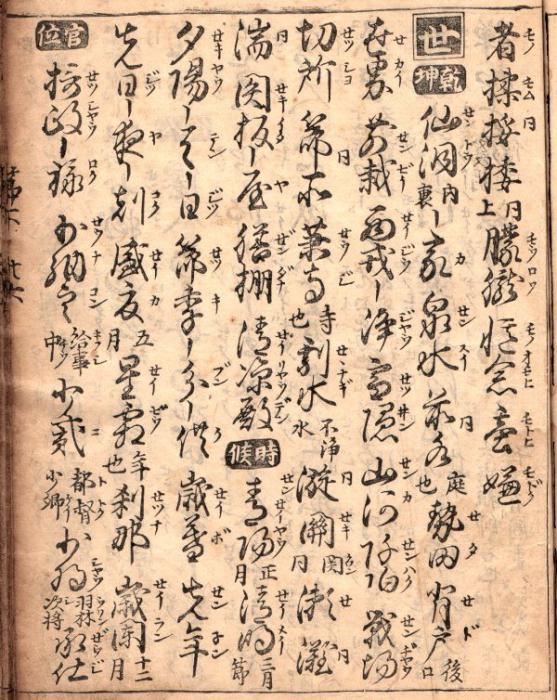
Hiragana and Katakan are the so-called syllable alphabet. But what do you mean by this term? It is simple: each character in hiragana and katakana is one syllable. Both go alphabetically in more detail later in this article. Most of you are probably already familiar with the fact that every Chinese character matters. For example, coverage terminals and other grammars, therefore, ultimately, some kind of kanji developed hiragana and katakana. As developed from kanji hiragana. The hiragan form is already present in the top line of the original character, in the bottom line.
Hieroglyphs and their pronunciation
Katakana, like the Japanese syllable alphabet, is fully consistent with all the canons of Kana. It contains exclusively consonant combinations, followed by open vowels. Very rarely there are nasal sonants, which are mostly mildly pronounced. There are few hieroglyphs in the alphabet: nine 36 open moors (syllables) and one bow ‘n, which is indicated by the sign знаком. It is also important to note that in the katakana all the hieroglyphs have precise and strict outlines. Their lines are straight, the endings are clear, intersections are always performed in one place.
Hiragana under the sign became known shortly after its beginning, because its use was written mainly by women who were previously not allowed to study complex kanji characters. During the Heian period, many literary works of women were written in hiragana. Moreover, when you watch a hiragana, you will see that its functions include many rounded shapes and various loops. Unlike the katakana, which at that time was used mainly by men, and which contain many perpendicular lines and equal strokes.
Katakana itself was founded a hundred years earlier than hiragana, thus in the eighth century. It arose as a hiragana simplification of Chinese kanji characters, but this time only parts of them. Originally a reference function for Buddhist monks in the pronunciation of various religious scriptures, like a hiragana is now used for small children or complex characters. They say it’s easier to learn katakana, hiragana earlier. Foreigners who learn Japanese because they tend to prefer and learn it first.
Learning katakana
Unfortunately, in this writing system, no one composed a simple poem that would help us learn all the hieroglyphs at once, using rhyme pleasant to hearing. Therefore, you can thoroughly learn katakana by studying the spoken language of the Japanese. Very often, to transfer any phenomena, names, names of animals and plants, and other borrowed words, hieroglyphics from this alphabet are used. However, it is worth remembering that, unlike hiragana, katakana does not combine with kanji and has, in principle, nothing to do with Chinese writing and pronunciation.
Of course, the question arises, why do the Japanese need two alphabets, when we need only one, and even sign the letter? The answer is much simpler than some people expect. There are simple rules that tell us that the alphabet is what is used.
Borrowed words are highlighted in the text of the telegram of interjections of the names of a foreign place. As for the historical reason why the Japanese use the two syllabic alphabet, which is even simpler: just get used to it. And, seeing this, indeed, maybe, since the rules for using hiragana and katakana are being decided, there is only about a hundred years. Before the sentence may seem calm as follows: 我 等 ハ 永世 ニ 亘 リ 平和 ヲ 希求 シ 且 今 ヤ 人類 ヲ 揺 リ 動 カ シ ツ ツ ア ル 人間 関係. The actual value of the proposal will not be considered; I would have decided to try to translate it myself.
Conclusion
In Japanese, there are still a number of alphabets, many of which are already considered dead. Residents of the Land of the Rising Sun today use only three of them - this is kanji (based on Chinese), hiragana and katakana. It is important to note that there is another writing system that is used in Japan - this is romaji. It consists of but the spelling conveys the sound of hieroglyphs. This writing system was developed for more comfortable communication with residents of the Western world.
However, as we see, in addition to confusing the sentence contains kanji and katakana a lot, despite the fact that today it will be used instead of hiragana. However, this is not entirely true, some Japanese syllables that we would not understand in the Czech Republic as syllables.
And this should not happen to us when learning Japanese; The Japanese do not officially have separate letters. Imagine a table of five columns and ten rows. In column headings, you can represent vowels and consonants in rows. As you can see, where the line meets the column, they are gathered together, and the syllable is in the world. But it is not so simple. This is because they have the wrong reading. In addition, the first row of the table is also counted in alphabetical order. All hiragana characters are shown in the following figure.
Katakana - syllable alphabet (each character means not sound, but syllable), used in Japanese. It is part of the modern Japanese language. It includes 46 characters (and a few obsolete ones). Katakana is used mainly for recording borrowed words and interjections. Borrowed words mean all foreign words, names and titles. Having studied katakana, you will be able to read most of the signs in stores, menus in restaurants, character names, web pages and inscriptions on Japanese discs. In fact, in most cases, English words are written in katakana, that is, it turns out something like transliteration of Russian words ( vi ponimaete, chto ya imeu v vidy ^ _ ^), and therefore with sufficient knowledge of the English language, you will understand what is at stake.
Words written for each syllable can be used as a dictionary or even mnemonic help if you see the hiragana symbol and you cannot remember how it is read. As you can see, there are not many of them, only し, ち, つ and ふ. The plates are with us, and we belonged to the Hiragana and Katakans, but they were designated as obsolete and were used for termination.
Modern Japanese simply do not use these five syllables, although for some of the Katakan words it may be different, namely, for example, Wakuraf. The following figures, depicting all the Hiragano and Katakan syllables, show small arrows showing how to write the syllable correctly.
In katakana, each symbol (with the exception of vowels and one exception) means not a letter, but a syllable - that is, a combination of consonant and vowel sounds. There are simply no symbols for consonants in the katakana. Each syllable has its own pronunciation, which never changes, regardless of the position of the syllable in the word or the syllables standing next to it, which is very convenient for remembering. True, there are composite sounds consisting of several syllables, but they are also always pronounced the same way.
This helps you learn and the person who reads the text. Katakan has the same number of characters as hiragana. The only difference between them, apart from use, is writing. Please note that irregular syllables are the same as in hiragana. As you already read about a few parts ago, katakana is mainly used to transcribe foreign words. However, this is not always the word transcribed by the kataka that sounds after reading the same thing that it sounded originally.
Admit yourself that without imagination it is sometimes difficult to guess what a given Katakkan word means. An example of a Czech decrypted word is, for example, a suction cup, a ball, etc. if you learn enough Japanese, these words will be routine for you, but in the meantime your imagination will work. Mnemonic instruments: all the syllables that you just learned are very pleasant, but they can be difficult to master.
The whole set of sounds is based on soft consonants (t, c, s, x). Their "hard" counterparts are obtained by adding two dashes to the original ( nigori) in the upper right corner of the icon. (If you do not understand, do not be alarmed, understand along the way). Now that the structure of the language (Katakana) has become a little clearer, let's move on to practical examples. I will write Japanese syllable writing, official syllable writing (in romaji), in brackets - an alternative option, if it is (in the Hepburn system), and through slash - Russian transcription (in the Polivanov system).
First of all, it should be remembered that many cataclysmic syllables are very similar to their hiragana counterparts or even completely identical. Namely, へ and ヘ, キ and き, ツ and つ, カ and か, etc. Mnemonic instruments for hiragana and katakana As you can see after viewing the hiragana syllable ふ, this syllable can remotely resemble your face.
In Japanese, the tree will say “ki,” as some of you may recall from a picture with a hiragana slightly higher. This mnemonic help also helped me a lot in the beginning. Extension of syllables: Japanese words, of course, like any other word in the world, sometimes require an extension of the wording of some of their vowels. Get it in Japanese is not difficult.
Vowel group
A / a - ordinary short open "a"
\u003d i / and - ordinary short open "and"
\u003d u / y - the usual short open "y"
\u003d e / e - ordinary short open "e"
\u003d o / o - ordinary short open "o"
Vowel Derivative Group
Ya / i
\u003d yu / yu
\u003d yo / ё
These derivative (compound) vowel syllables are used not only on their own to convey sound, but also in syllabic formation, as additional parts of the syllable to explain its pronunciation (see below).
Consonant exception
N / n - nasal syllabic "n". It is not softened by subsequent vowels, which in the transcription is transmitted as "n".
Consonant Group "KG"
Ka / ka
\u003d ki / ki
\u003d ku / ku
\u003d ke / ke
\u003d ko / ko
Ga / ha
\u003d gi / gi
\u003d gu / gu
\u003d ge / ge
\u003d go / go
Consonant Group TD
Ta / ta
\u003d ti (chi) / ty
\u003d tu (tsu) / tsu
\u003d te / te
\u003d to / then
Da / yes
\u003d di / di
\u003d du / du
\u003d de / de
\u003d do / before
Consonant Group "SZ"
Sa / sa
\u003d si (shi) / si
\u003d su / su
\u003d se / se
\u003d so / co
Za / Dza
\u003d zi (ji) / ji
\u003d zu / zu
\u003d ze / ze
\u003d zo / zo
Group of consonants "HBP"
Ha / ha
\u003d hi / hee
\u003d hu (fu) / hu - the Japanese do not distinguish between "hu" and "fu"
\u003d he / he
\u003d ho / ho
Ba / ba - sometimes used as a "va"
\u003d bi / bi
\u003d bu / bu
\u003d be / be
\u003d bo / bo
Pa / pa
\u003d pi / pi
\u003d pu / pu
\u003d pe / pe
\u003d po / po
As you can see, the Japanese liked the letter "x" so much that they decided to form not one, but two whole "solid" sounds out of it! ^ _ ^ The sound "b" is marked with the usual dashes, and the "n" - with a circle ( hannigory).
Consonant Group "H"
Na / on
\u003d ni / neither
\u003d nu / well
\u003d ne / ne
\u003d no / but
Consonant Group "M"
Ma / ma
\u003d mi / mi
\u003d mu / mu
\u003d me / me
\u003d mo / mo
Consonant Group "P"
Ra / Ra
\u003d ri / ri
\u003d ru / ru
\u003d re / re
\u003d ro / ro
Note: the Japanese do not distinguish between the sounds "p" and "l."
Consonant Group "B"
It's all! The letter c is not complete. Previously, the syllables “va”, “vo”, “ve”, etc., were actually present in it, but they came out of modern use due to changes in syllabic formation.
Special mark
It does not have its own pronunciation
In Japanese, there is a special symbol denoting the doubling of the initial consonant of the next syllable. You noticed, it looks like a reduced katakana "tu / tsu", but it does not have its own pronunciation (like our soft or hard sign). Its purpose is to emphasize the pronunciation of the initial consonant in any syllable. In fact, its presence in the word shows that the initial consonant of the syllable following it must be pronounced twice, that is, for example, the syllable "that" will turn into "t-that." As part of the word, it will look like: "lo-that" \u003d\u003e "lo-that." Agree, the second option sounds much better and is more similar in pronunciation to the Russian version. Here is an example:
Congratulations! You have completed the study of katakana! This was the last character. True, there are still a few subtleties, which I will discuss below.
Spelling examples
Now that (if) you remember the spelling and pronunciation of all the characters, I will give some examples of writing simple words. Of course, there were some nuances that I did not explain, but I will do this later.
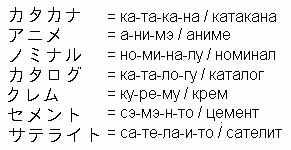
With English words, everything is exactly the same. Yes, by the way, if you wonder why I wrote katakana syllables "ru" and "ra", and translated them as "lu" and "la", then read on. If you did not notice this, then you should once again re-read the above text and understand the writing of syllables.
Pronunciation of long vowels
When it seems to the Japanese that a syllable or vowel is pronounced unforgivably long, that is, longer than its "classical" pronunciation, they mark it in the Katakana record, putting a long horizontal line (like our dash) after the syllable or vowel. In fact, figuring out when a sound lasts long enough to mark it with a trait is extremely difficult (I never succeed), so this point is important only for reading the text. It’s almost impossible to determine when to put a line in the record itself, since the ideas of Russians, British and Japanese about the longitude of sounds vary greatly. Here is a more or less obvious example, this time, for a change, in English.
Note: an almost accurate sign of a “long” sound is a double vowel. Almost certainly, instead of the doubled vowel in the Katakana record, you need to put a dash - a sign of longitude.
The problem of "identical" sounds. "R - L", "X - F"
The fact is that because of the peculiarities of their language, the Japanese do not distinguish some sounds that sound the same to them. (Nothing funny! But do you hear by ear the difference in pronunciation between "two", "too" and "to"?) This feature applies to "b-c", "ji-ji", "shi-si", etc. d., but most noticeably in the sounds of "r-l" and "hf". Therefore, to reproduce the sound “l”, a series of letters “p” is used, and for the sound “f”, a series of letters “x” is used. However, not everyone was happy with this system, so a new form of recording was adopted, using a combination of several syllables. Now for the sound "f" the following spelling is used:
Fa / fa
\u003d fi / fi
\u003d fu / fu - aka "hu / hu"
\u003d fe / fe
\u003d fo / fo
As you can see, the basic syllable is "hu." We agreed that if you add a vowel to it, it will denote a syllable with the letter "f". The vowel used to form a new syllable is written in a smaller font to show this. However, some are too lazy to reduce something there, so do not be surprised if you see a vowel added to the syllable of a large (like the syllable itself) size - this is in the order of things.
Completely exhausted by such a grand reform of the language, the Ministry of Education of Japan decided not to touch the sound "p", so get used to using the sound "p" instead of "l", it's not so scary, or change the keyboard layout. ^ _ ^
This is how Final Fantasy recorded by Katakana looks, for example:
The formation of sounds of the consonant group "B"
You are probably tormented by the question: if there is only a katakana "va", then how are other syllables with the letter "b" formed, for example, "in" or "ve"? Or do they not exist at all? By the way, in Japanese they really are ... they don’t exist (or rather, they don’t differ from the sound “b”), but they are still present for recording foreign words (as is the case with the sound “f”). There is no unified syllabic system, but the almost official version looks like this:
Wa / wa
\u003d wi / vi
\u003d wu / wu - aka "u / y"
\u003d we / ve
\u003d wo / wo
Note: sometimes you can find the old spelling of these syllables that is not used in modern speech, which I will now cite as information, so that you are not surprised if you meet such somewhere in the text.
Wi / Wi - not used
\u003d we / ve - not used
\u003d wo / wo - not used
I continue to load further, because the situation with the sound “in” is far from complicated, since in English two sounds “in” are “w” and “v”, which differ from each other, therefore there is also a record for the sounds of the group in the Katakana "v". These syllables are also based on the vowel "y", but nigori are added to them, since the sound "v" is harder. Next, a generative vowel (small size) is added, and we get the finished syllable.
Va / va
\u003d vi / vi
\u003d vu / wu
\u003d ve / ve
\u003d vo / vo
Note: instead of the syllable "va / wa", the syllable "ba / ba" can be freely used, because in Japanese the difference between the two could not be distinguished (yes and no).
For Russians, all of these syllables with an “c” sound almost the same, so choosing a form of writing plays a role only when writing English words. Although, in my opinion, it is more competent to use the group "w" to write Russian words, since it is more consistent in the pronunciation of the Russian "v", and Japanese, too.
Total: if you understand everything with the letter "B" and its syllables, then you really understand Japanese and English! Although, in fact, everything is not so complicated, for syllables other than "wa / wa" are rarely used by the Japanese. Here you just need to remember that there is a katakana of the sound “wa / wa”, and all other syllables with “in” are built on the basis of “y” by adding the corresponding vowels.
Derived syllable formation
If there are derivative vowels, then there must be some derivative syllables where these vowels are used. If you think so, then you are absolutely right. The rules for their education are very simple. Any basic syllable is taken - "consonant_with_sound_" and "", after this syllable is written a reduced "I", "u" or "e". We get a new syllable - "consonant_ with derivative_sound", i.e. when pronouncing, the old sound "and" is discarded, and the derivative vowel is pronounced instead. I will not give all possible syllables, but you must understand the principle itself. Here's what it looks like:
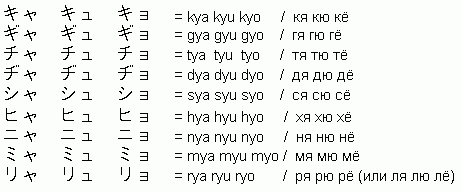
Note: sometimes a derivative vowel is written the same size as all other syllables. In this case, if it stands after a syllable ending in the sound "and" (sound, not katakana "and"!), Then we are still dealing with a derived syllable. And if it stands after any other syllable, except for "consonant + and", it sounds by itself.

